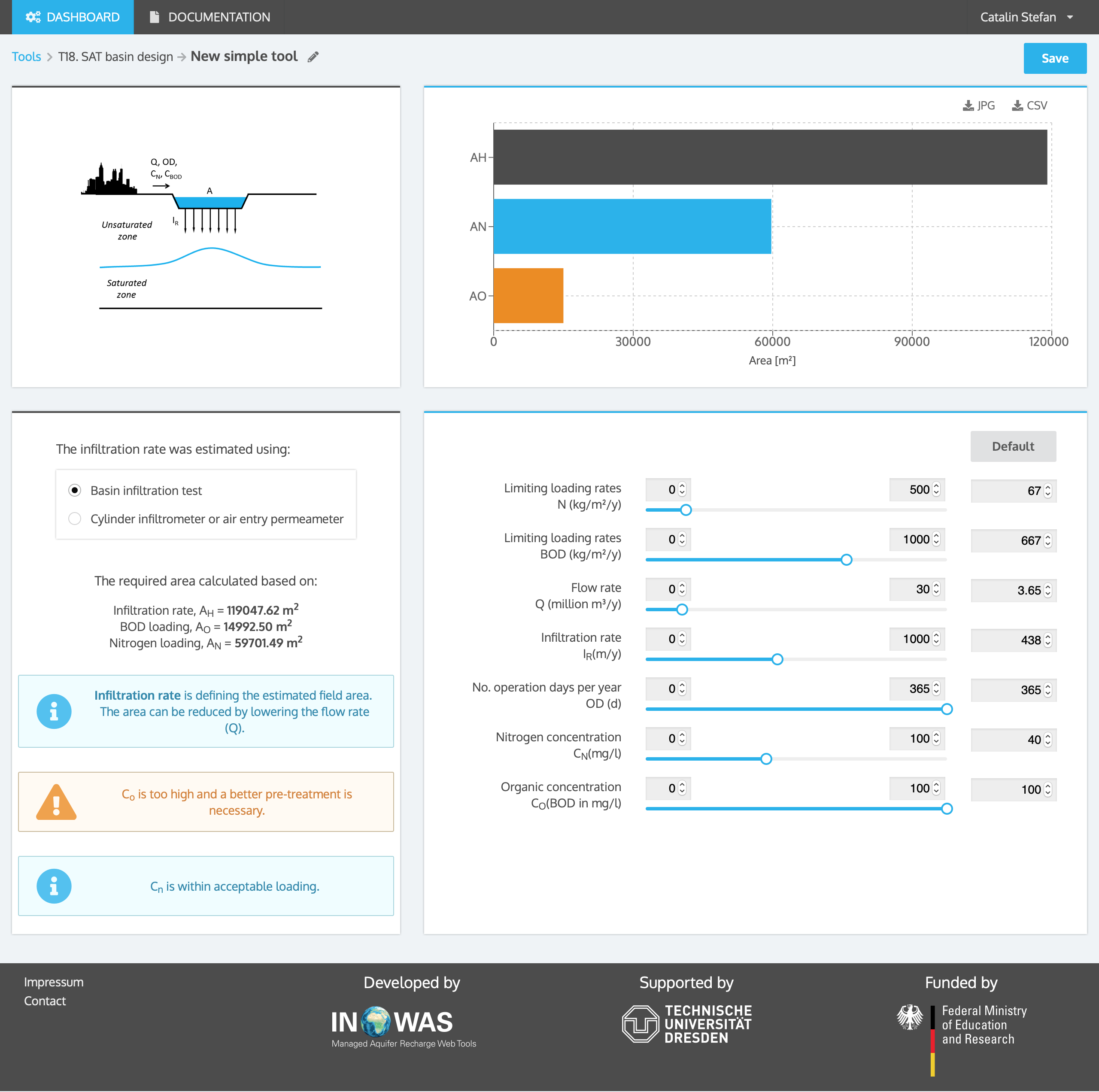The tool contains empirical equations that can be used to design a typical soil aquifer treatment (SAT) system including hydraulic loading rates and land requirements under consideration of hydraulic characteristics of the soil and water quality such as nitrogen loading and organic loading respectively water quality requirements. The calculations are based on Crites (2014).
Hydraulic loading rate, HLR
The hydraulic loading rate (HLR) defines the rate water is infiltrated per year and per square meter. It is the most important and critical design parameter for planning infiltration basins. The hydraulic loading rate is a function of the site-specific hydraulic capacity dependent on soil texture and bulk density. In some cases the nitrogen or organic loading can control the land required for infiltration; however, the limiting design factor for SAT systems is usually the infiltration/percolation rate.
The hydraulic loading rate used for designing the SAT system is the measured clean water infiltration rate multiplied by an adjustment factor which is depending on the procedure used for measuring the infiltration rate, on the variation in infiltration rate over the site and on the conservatism of the designer (eq. 1).
| (eq. 1) |
where
| HLR | = Hydraulic loading rate [LT-1] |
| IR | = Measured clean water infiltration rate [LT-1] |
| af | = Adjustment factor [-] |
Adjustment factors account for the intermittent loading and drying in an SAT system and the long-term decrease in infiltration rates due to clogging processes as a result of wastewater loadings. Typical adjustment factors for different field tests are presented in the table below:
| Percent of measured infiltration rate values | ||
| Test procedure | Conservative range | Less conservative range |
| Basin infiltration test | 5-7% |
8-10% |
| Cylinder infiltrometer or air entry permeameter | 1-2% | 2-4% |
Nitrogen loading rate, NLR
The total nitrogen loading rate (NLR) should be kept below 67 kg/ha*d (limiting loading rate – LLRN). The nitrogen loading rate is calculated based on the hydraulic loading rate and the nitrogen concentration in the water (eq. 2):
| (eq. 2) |
where
| NLR | = Nitrogen loading rate [ML-2T-1] |
| HLR | = Hydraulic loading rate [LT-1] |
| CN | = Nitrogen concentration in water [ML-1] |
| D | = Number of operating days per year [T] |
Organic loading rate, OLR
Biological oxygen demand (BOD) is used as a measure for organic loading. The total BOD loading rate should generally be kept lower that 667 kg/ha*d (limiting loading rate – LLRO), whereas for municipal systems, a limit of about 336 kg/ha·d is recommended. The determination of the BOD loading rate based on the hydraulic loading rate and the BOD concentration in the water occurs according to equation 3.
| (eq. 3) |
where
| OLR | = Organic loading rate [ML-2T-1] |
| HLR | = Hydraulic loading rate [LT-1] |
| CO | = Concentration of organic matter in water expressed in biological oxygen demand (BOD) [ML-1] |
| D | = Number of operating days per year [T] |
Field area, A
The area required for an SAT system is calculated based on the hydraulic loading rate and the annual water flow rate into the system (eq. 4):
| (eq. 4) |
where
| AH | = Field area [L2] |
| Q | = Annual water flow rate into basin [L3T-1] |
| HLR | = Hydraulic loading rate [LT-1] |
In some cases, the required area can be decided by the high concentration of nitrogen or organic matter in the infiltration water. In theses cases, the respective areas ANand AOneed to be calculated based on nitrogen and organic matter concentration and the corresponding limiting loading rates LLRNand LLRO (eq. 5 and 6). The final required area is then the maximum area between AH, ANand AO.
| (eq. 5) |
| (eq. 6) |
where
| AN, AO | = Field area [L2] |
| CN, CO | = Nitrogen / organic matter concentration (expressed as BOD) in the water [ML-1] |
| Q | = Annual water flow rate into basin [L3T-1] |
| LLRN, LLRO | = Limiting nitrogen or organic loading rate [ML-2T-1] |
The online calculator needs user-supplied values for infiltration rate (IR) measured by infiltration test, annual water flow to the basin (Q), nitrogen and organic matter concentration (CN/CO) in the water flowing into the basin.
Example
A new soil-aquifer-treatment (SAT) plant needs to infiltrate pre-treated wastewater from a community of 100,000 equivalent inhabitants. The daily average wastewater discharge is 100 l/inhabitant. The volume of water to be infiltrated in one year is thus Q = 3.65 million m3. After pre-treatment, the BOD concentration is reduced to 100 mg/l and the nitrogen concentration to 40 mg/l. The soils on the site have a moderate variability and the minimum infiltration rate, determined by basin infiltration tests, is 50 m/h. Using a correction factor of 7%, the hydraulic loading rate is HLR = 31 m/year. In case of 365 operating days per year, the calculated nitrogen loading rate (NLR = 34 kg/ha*d) is lower than the limiting nitrogen loading rate (LLRN = 67 kg/ha*d), so the nitrogen loading is not a limiting factor for the calculation of the necessary field area for infiltration. The same applies also for the organic loading rate (OLR = 85 kg/ha*d), which is lower than the limiting organic loading rate (LLRO = 667 kg/ha*d). The field area required based on HLR AH = 118,000 m2, while the field area based on the LLRN is AN = 60,000 m2 and based on LLRO is AO = 15,000 m2. The required field area for infiltration is the biggest of the three calculated areas, A = 118,000 m2.

REFERENCES
- Crites, R.W., Middlebrooks, E.J., Bastian, R.K., 2014. Natural Wastewater Treatment Systems, Second Edition. CRC Press.
